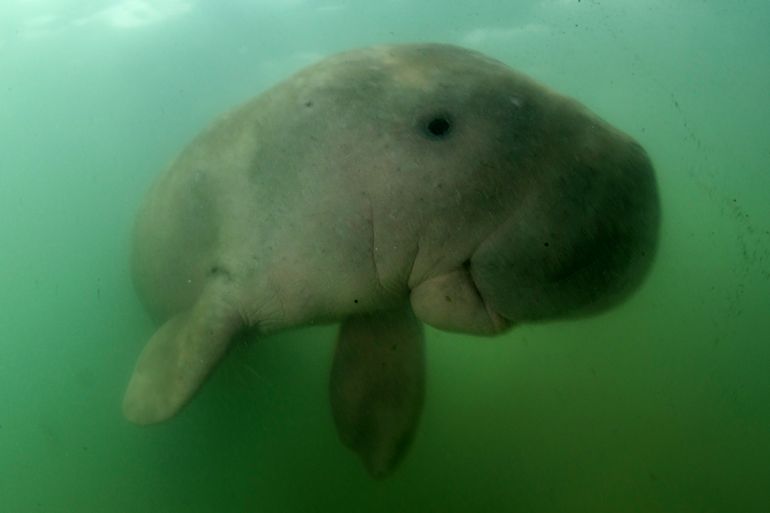Marine mammals, corals pushed to extinction: Conservation group
IUCN sounds alarm over growing extinction threat to large marine mammals, abalone species and Caribbean corals.

Populations of a vulnerable species of marine mammals, numerous types of abalone and Caribbean corals are now threatened with extinction, an international conservation organisation has said.
The International Union for Conservation of Nature (IUCN) announced the update during the United Nations Convention on Biological Diversity, or COP15, conference in Montreal on Friday.
Keep reading
list of 3 itemsWill rich nations pay for the climate ‘loss and damage’ fund?
Greta Thunberg, 600 others sue Sweden for climate inaction
The global conservation body uses its Red List of Threatened Species to categorise animals that are approaching extinction. This year, the union is sounding the alarm about the dugong – a large and docile marine mammal that lives from the eastern coast of Africa to the western Pacific Ocean.
The dugong, a grey herbivorous mammal commonly known as the sea cow, is vulnerable throughout its range, and its population in East Africa has entered the Red List as critically endangered, IUCN said in a statement. Its population in the French territory of New Caledonia has entered the list as endangered.
There are now fewer than 250 adult dugongs in East Africa and under 900 in New Caledonia.
The major threats to the animals are unintentional capture in fishing gear in East Africa and poaching in New Caledonia, IUCN said. They also suffer from boat collisions and loss of seagrass, their main food source, said Evan Trotzuk, who led the East Africa Red List assessment.
Additional threats come from oil and gas exploration and production in Mozambique and pollution caused by nickel mining in the Pacific.
“Strengthening community-led fisheries governance and expanding work opportunities beyond fishing are key in East Africa, where marine ecosystems are fundamental to people’s food security and livelihoods,” Trotzuk said.
Scientists, rights advocates and delegates from nearly 200 countries gathered in Canada at COP15 this week to tackle the loss of biodiversity and what can be done to reverse it.
For years, experts have sounded the alarm over how climate change and other factors are leading to an “unprecedented” decline in animals, plants, and other species, and threatening various ecosystems.
UN Secretary-General Antonio Guterres warned of catastrophic results if what he called “this orgy of destruction” of ecosystems is not stopped.
“With our bottomless appetite for unchecked and unequal economic growth, humanity has become a weapon of mass extinction,” Guterres said at the opening of COP15 on Tuesday.
The IUCN Red List includes more than 150,000 species, from which more than 42,000 are threatened with extinction.
The Red List is typically updated two or three times a year. This week’s update has more than 3,000 additions.
Jane Smart, head of IUCN’s Centre for Science and Data, said it will take political will to save the jeopardised species, and the gravity of the new listings can serve as a call for action.
Pillar coral, which is found throughout the Caribbean from the Yucatan Peninsula and Florida to Trinidad and Tobago, was moved from vulnerable to critically endangered.
The coral is threatened by a tissue loss disease, and its population has shrunk by more than 80 percent across most of its range since 1990, said IUCN, which lists more than two-dozen corals in the Atlantic Ocean as critically endangered.
Almost half the corals in the Atlantic are “at elevated risk of extinction due to climate change and other impacts,” said Beth Polidoro, an associate professor at Arizona State University and Red List coordinator for IUCN.
Unsustainable harvesting and poaching have emerged as threats to abalone, a type of mollusc that is sold as some of the world’s most expensive seafood. Twenty of the 54 abalone species in the world are threatened with extinction according to the Red List’s first global assessment of the species.
The union’s hundreds of members include government agencies from around the world in one of the planet’s widest-reaching environmental networks.
“Most of the Earth’s biosphere, 99 percent of all liveable space on our planet, is under water,” said Jon Paul Rodriguez, chair of the IUCN Species Survival Commission.
“Humanity acts as if oceans were inexhaustible, capable of sustaining infinite harvest of algae, animals and plants for food and other products, able to transform vast quantities of sewage and other pollutants that we pour in coastal areas, and absorb the CO2 generated by land-use change and burning fossil fuel.”